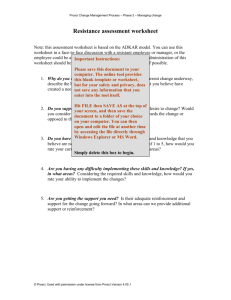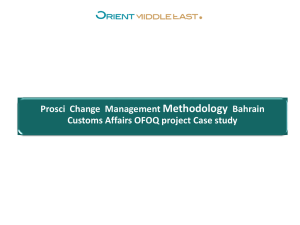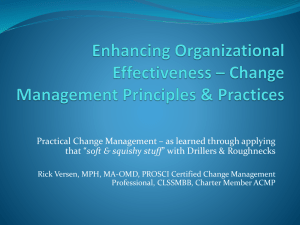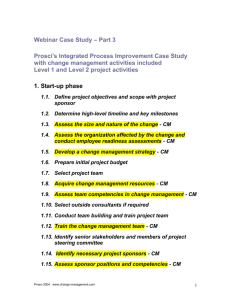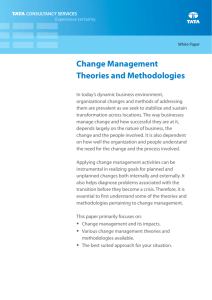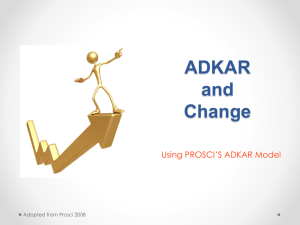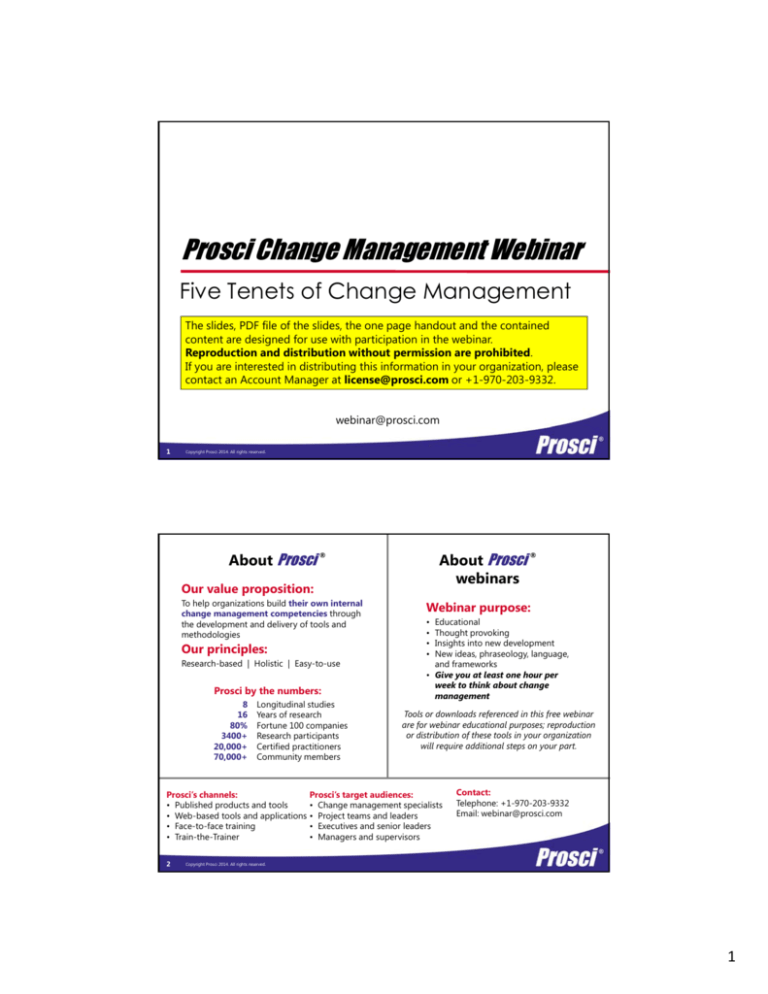
Prosci Change Management Webinar
Five Tenets of Change Management
The slides, PDF file of the slides, the one page handout and the contained
content are designed for use with participation in the webinar.
Reproduction and distribution without permission are prohibited.
If you are interested in distributing this information in your organization, please
contact an Account Manager at license@prosci.com or +1-970-203-9332.
webinar@prosci.com
1
Copyright Prosci 2014. All rights reserved.
About Prosci
About Prosci
webinars
®
Our value proposition:
To help organizations build their own internal
change management competencies through
the development and delivery of tools and
methodologies
O principles:
Our
i i l
Research-based | Holistic | Easy-to-use
Prosci by the numbers:
8
16
80%
3400+
20,000+
70,000+
Longitudinal studies
Years of research
Fortune 100 companies
Research participants
Certified practitioners
Community members
Webinar purpose:
•
•
•
•
Educational
Thought provoking
s g ts into
to new
e de
development
e op e t
Insights
New ideas, phraseology, language,
and frameworks
• Give you at least one hour per
week to think about change
management
Tools or downloads referenced in this free webinar
are for webinar educational purposes; reproduction
or distribution of these tools in your organization
will require additional steps on your part.
Prosci’s target audiences:
Prosci’s channels:
• Change management specialists
• Published products and tools
• Web-based tools and applications • Project teams and leaders
• Executives and senior leaders
• Face-to-face training
• Managers and supervisors
• Train-the-Trainer
2
®
Contact:
Telephone: +1-970-203-9332
Email: webinar@prosci.com
Copyright Prosci 2014. All rights reserved.
1
Agenda
• Two paths for answering
why change management
management”
“why
Blank sheet
of paper
• Prosci’s Five Tenets of
Change Management
• Applying the tenets
to your work
3
Copyright Prosci 2014. All rights reserved.
Release of the 2nd Edition of
Change Management: The People Side of Change
First released: Fall 2003
45 000+ in circulation
45,000+
Second edition released Dec 2012
Rewrite of Chapter 1:
“Why
Why change management?
management?”
Advancement and simplification of
the case for change management
4
Copyright Prosci 2014. All rights reserved.
2
Two Paths for Answering
“Why Change Management?”
1st edition:
2nd edition:
Advantages of applying
change management
The reality of how change actually
happens in an organization which leads to
the necessity of change management
Five Tenets
Consequences of not applying
change management
5
Copyright Prosci 2014. All rights reserved.
“Priority is a function
of context.”
context ”
-Stephen R. Covey
The Five Tenets give appropriate
context to change management
= desired benefits and outcomes
6
Copyright Prosci 2014. All rights reserved.
3
Prosci Five Tenets
7
8
1
We change for a reason.
2
Organizational change requires individual change.
3
Organizational outcomes are the collective result of
individual change.
4
Change management is an enabling framework for
managing the people side of change.
change
5
We apply change management to realize the benefits
and desired outcomes of change.
Copyright Prosci 2014. All rights reserved.
1
We change for a reason.
2
Organizational change requires individual change.
3
Organizational outcomes are the collective result of
individual change.
4
Change management is an enabling framework for
managing the people side of change.
change
5
We apply change management to realize the benefits
and desired outcomes of change.
Copyright Prosci 2014. All rights reserved.
4
1
We change for a reason.
What is change?
A movement
out of
Through
Th
h
To ultimatelyy
reach
Current
Transition
Future
* Arnold Van Gennep
“The Rites of Passage”
9
+
Most other contributors
to the discipline
Copyright Prosci 2014. All rights reserved.
1
We change for a reason.
Issues & Opportunities
I
Internal
l performance
f
Strategic plans
Customer input
Market shifts
Financial results
Competitive threats
New technologies
Economic conditions
Regulation/legislation
Demands to do more with less
10
Copyright Prosci 2014. All rights reserved.
5
1
We change for a reason.
Current
Change drivers:
•
•
•
•
•
•
•
•
11
Strategic plans
Internal performance
Market and economic shifts
Customer input
Competitive threats
New technologies
g
Regulation/legislation
Demands to do more with less
Future
Change goals:
•
•
•
•
•
•
•
Costs lower
Revenues higher
Market share larger
Errors fewer
Efficiency greater
Customers more satisfied
Risk exposure less
Copyright Prosci 2014. All rights reserved.
1
We change for a reason.
The reason we change is to reach a future state where
performance is better than in the current state.
Future
12
>
Current
Copyright Prosci 2014. All rights reserved.
6
1
1
2
List the “reasons”
f your change:
for
What are the
objectives, benefits
and expected
results and
outcomes for the
project or initiative?
3
4
5
13
14
Reasons
Copyright Prosci 2014. All rights reserved.
1
We change for a reason.
2
Organizational change requires individual change.
3
Organizational outcomes are the collective result of
individual change.
4
Change management is an enabling framework for
managing the people side of change.
change
5
We apply change management to realize the benefits
and desired outcomes of change.
Copyright Prosci 2014. All rights reserved.
7
Organizational change requires
individual change.
2
We tend to focus on “organizational
g
change”
g
Implementing an ERP
Installing Electronic
Medical Records
Future
Documenting and optimizing
business processes
Move to a new
physical location
15
Copyright Prosci 2014. All rights reserved.
Organizational change requires
individual change.
2
g
change
g impacts
p
how
But each organizational
specific employees do their jobs
C
I had used the old legacy system…
16
F
Now I’m using the new integrated system
Copyright Prosci 2014. All rights reserved.
8
Organizational change requires
individual change.
2
But each organizational
g
change
g impacts
p
how
specific employees do their jobs
C
17
C
F
F
I had used the old legacy system…
Now I’m using the new integrated system
I had done what I needed to…
Now I’m following the new processes
Copyright Prosci 2014. All rights reserved.
Organizational change requires
individual change.
2
g
change
g impacts
p
how
But each organizational
specific employees do their jobs
C
18
C
C
F
F
F
I had used the old legacy system…
Now I’m using the new integrated system
I had done what I needed to…
Now I’m following the new processes
I had reported to…
Now I’m reporting to
Copyright Prosci 2014. All rights reserved.
9
Organizational change requires
individual change.
2
But each organizational
g
change
g impacts
p
how
specific employees do their jobs
19
C
C
C
C
C
F
F
F
F
F
C
C
C
C
C
F
F
F
F
F
C
C
C
C
C
F
F
F
F
F
C
C
C
C
C
F
F
F
F
F
C
C
C
C
C
F
F
F
F
F
Copyright Prosci 2014. All rights reserved.
Organizational change requires
individual change.
2
g is the individual
The true unit of change
C
C
C
C
C
T
T
T
T
T
F
F
F
F
F
C
C
C
C
C
T
T
T
T
T
F
F
F
F
F
C
TTransition
T T T T
F
F F F
Future
F
C
20
C C C
Current
C
C
C
C
C
T
T
T
T
T
F
F
F
F
F
C
C
C
C
C
T
T
T
T
T
F
F
F
F
F
Copyright Prosci 2014. All rights reserved.
10
2
1
2
Identify the
groups impacted
by the change:
Which individuals
have to do their
jobs differently
when this change is
implemented?
3
4
5
21
22
Reasons
Impacted
groups
Copyright Prosci 2014. All rights reserved.
1
We change for a reason.
2
Organizational change requires individual change.
3
Organizational outcomes are the collective result of
individual change.
4
Change management is an enabling framework for
managing the people side of change.
change
5
We apply change management to realize the benefits
and desired outcomes of change.
Copyright Prosci 2014. All rights reserved.
11
3
Organizational outcomes are the
collective result of individual change.
The results and outcomes of workplace changes
“The
are intrinsically and inextricably tied to individual
employees doing their jobs differently.”
Page 1, Change Management: The People Side of Change
The organization only reaches its Future State
if individuals reach their own Future States.
23
Copyright Prosci 2014. All rights reserved.
C
T
F
C
T
F
C
T
F
C
T
F
C
T
F
C
T
F
C
T
F
C
T
F
Future
24
Copyright Prosci 2014. All rights reserved.
12
Organizational outcomes are the
collective result of individual change.
3
Speed of adoption: How quickly employees
move through their transition state
Slow
25
Faster
Fastest
T
T
T
T
T
T
T
T
T
T
T
T
T
T
T
T
T
T
T
T
T
T
T
T
T
T
T
T
T
T
T
T
T
T
T
T
T
T
T
T
T
T
T
T
T
T
T
T
T
T
T
T
T
T
T
T
T
T
T
T
T
T
T
T
T
T
T
T
T
T
T
T
T
T
T
Copyright Prosci 2014. All rights reserved.
3
Organizational outcomes are the
collective result of individual change.
Ultimate utilization: How many
employees
l
reach
h their
th i future
f t
state
t t
26
F
F
F
F
F
F
F
F
F
F
F
F
F
F
F
F
F
F
F
F
F
F F F
Future
F
F
F F F
Future
F
F
F
F
F
F
F
F
F
F
F
F
F
F
F
F
F
F
F
F
F
Copyright Prosci 2014. All rights reserved.
13
3
Organizational outcomes are the
collective result of individual change.
Proficiency: How successfully employees
perform
f
in
i their
th i future
f t
state
t t
27
F
F
F
F
F
F
F
F
F
F
F
F
F
F
F
F
F
F
F
F
F
F F F
Future
F
F
F F F
Future
F
F
F
F
F
F
F
F
F
F
F
F
F
F
F
F
F
F
F
F
F
Copyright Prosci 2014. All rights reserved.
3
Organizational outcomes are the
collective result of individual change.
Especially with today’s changes,
one employee
l
nott reaching
hi his/her
hi /h future
f t
state
t t
can prevent the project from delivering results
F
F
F
F
F
F
F
F
F
F
F
F
F
F
F
F
F
F
F
F
F
F
F
F
F
F
F
F
F
F
F
F
F
F
F
F
F
F
F
F
F
F
F
F
F
F
F
F
F
F
Future
Future
e.g. Enterprise Resource Planning end-to-end solution
28
Copyright Prosci 2014. All rights reserved.
14
3
Organizational outcomes are the
collective result of individual change.
j
ROI,
Project
results and
outcomes
F t
Future
29
F
F
F
F
F
F
F
F
F
F
F
F tF F
Future
F
F
F
F
F
F
F
F
F
F
F
F
Copyright Prosci 2014. All rights reserved.
3
Organizational outcomes are the
collective result of individual change.
Objective #1
Project
objectives:
Objective #2
Future
Objective #3
Objective #4
30
successful
individual
transitions
depend
on
F
F
F
F
F
F
F
F
F
F
F
F
F
F
F
F
F
F
F
F
F
F
F
F
F
F
F
F
Impacted
groups
Copyright Prosci 2014. All rights reserved.
15
1
2
3
4
5
31
32
Draw the
connections:
Which groups must
adopt and use the
change in order for
each “reason” or
objective to be
achieved?
Reasons
3
Impacted
groups
Connections
Copyright Prosci 2014. All rights reserved.
1
We change for a reason.
2
Organizational change requires individual change.
3
Organizational outcomes are the collective result of
individual change.
4
Change management is an enabling framework for
managing the people side of change.
change
5
We apply change management to realize the benefits
and desired outcomes of change.
Copyright Prosci 2014. All rights reserved.
16
Change management is an enabling framework
for managing the people side of change.
4
We need change
g management
g
because:
The results and outcomes of change are based
on the success of individual transitions
Change management provides the answer to:
How can we enable and encourage employees
to embrace, adopt and use a change in their
day-to-day work resulting from a project?
33
Copyright Prosci 2014. All rights reserved.
Change management is an enabling framework
for managing the people side of change.
4
How can we help employees out of their current state?
How
can we help
through
H
h l employees
l
th
h their
th i transition
t
iti state?
t t ?
How can we help employees arrive at their future state?
34
C
C
C
C
C
T
T
T
T
T
F
F
F
F
F
C
C
C
C
C
T
T
T
T
T
F
F
F
F
F
C
C
C
C
C
T
T
T
T
T
F
F
F
F
F
C
C
C
C
C
T
T
T
T
T
F
F
F
F
F
C
C
C
C
C
T
T
T
T
T
F
F
F
F
F
Copyright Prosci 2014. All rights reserved.
17
4
Change management is an enabling framework
for managing the people side of change.
Individual Change Management
How does one person make a change successfully?
The Prosci® ADKAR® Model
Awareness
Desire
Knowledge
Ability
Reinforcement ®
35
of the need for change
to participate and support the change
on how to change
to implement required skills and behaviors
to sustain the change
Copyright Prosci 2014. All rights reserved.
4
Change management is an enabling framework
for managing the people side of change.
Organizational Change Management
What can the project team and change management
resources do to support those individual transitions?
Develop a customized and scaled approach
Readiness assessments, Risk evaluation, Impact Index,
Special tactics, Sponsor assessment diagram, Team preparation
Create deliverables and p
plans to support
pp
ADKAR
Communication plan, Sponsor roadmap, Coaching plan,
Training plan, Resistance management plan
Ensure that the change sticks
Feedback collection, Compliance audits, Gap identification,
Corrective actions, Success celebrations, Measurement
36
Copyright Prosci 2014. All rights reserved.
18
1
2
3
4
5
37
38
Reasons
Document change
management
approach:
• Are we using a
structured approach?
• Is it scaled and
customized?
• Who
Wh iis d
doing
i th
the
change management?
• Do we have a budget?
Impacted
groups
Connections
4
Change
management
approach
Copyright Prosci 2014. All rights reserved.
1
We change for a reason.
2
Organizational change requires individual change.
3
Organizational outcomes are the collective result of
individual change.
4
Change management is an enabling framework for
managing the people side of change.
change
5
We apply change management to realize the benefits
and desired outcomes of change.
Copyright Prosci 2014. All rights reserved.
19
We apply change management to realize the
benefits and desired outcomes of change.
5
Because results and desired outcomes
depend on individual transitions
Organizational
Individual
depends on
Future
39
F
F
F
F
F
F
F
F
F
F
F
F
F
F
F
F
F
F
F
F
F
F
F
F
F
Copyright Prosci 2014. All rights reserved.
We apply change management to realize the
benefits and desired outcomes of change.
5
Because there are “people side” factors that
determine or constrain project ROI
Speed of adoption
T
T
T
T
T
T
T
T
T
T
T
T
T
T
T
F
T
T
T
T
T
T
T
T
T
T
Slow
40
Ultimate utilization
Faster Fastest
Proficiency
F
F
F
F
F
F
F
F
F
F
F
F F F
Future
F
F
F F F
Future
F
F
F
F
F
F
F
F
F
F
F
F
F
F
F
F
F
F
F
F
F
Opt in vs. Opt out
Ability to perform
Copyright Prosci 2014. All rights reserved.
20
We apply change management to realize the
benefits and desired outcomes of change.
5
Because there are costs and risk of ignoring or
mismanaging the people side of change
Costs
Risks
Individuals
Project
j
REwork
REdo
REtrain
REdesign
REcope
REtreat
+ costs and risks of not
attaining desired benefits
and outcomes
Organization
41
The REs:
Copyright Prosci 2014. All rights reserved.
We apply change management to realize the
benefits and desired outcomes of change.
5
Because the data shows that we dramatically
increase our likelihood of success when we
apply effective change management
Percent of re
espondents that met
or exceeded
d project objectives
100%
96%
80%
77%
60%
40%
46%
20%
16%
0%
Poor
Fair
Good
(n=244)
(n=653)
(n=834)
Overall effectiveness of change management program
42
Excellent
(n=165)
Copyright Prosci 2014. All rights reserved.
21
5
We apply change management to realize the
benefits and desired outcomes of change.
Regardless of the “story” we choose, the underlying
reason for applying change management is tied to
project results, outcomes and benefits
Unit of change is the individual
Speed of adoption, Ultimate utilization, Proficiency
Costs, Risks, REs
Project:
Results
Outcomes
Benefits
Correlation to success
43
Copyright Prosci 2014. All rights reserved.
1
2
How will we know:
3
4
5
• If employees are
adopting and
using the change?
• If benefits are
realized and
outcomes are
achieved?
44
Reasons
Impacted
groups
Connections
5
Change
management
approach
Measurement
and metrics
Copyright Prosci 2014. All rights reserved.
22
Applying the Five Tenets to Your
Projects and Initiatives
45
1
We change for a reason.
2
Organizational change requires individual change.
3
Organizational outcomes are the collective result of
individual change.
4
Change management is an enabling framework for
managing the people side of change.
5
We apply change management to realize the benefits
and desired outcomes of change.
Copyright Prosci 2014. All rights reserved.
Interview questions for your project managers and team members:
1. We change for a reason.
Q: What are the reasons for your change?
2. Organizational change requires individual change.
Q: Who has to do their jobs differently as a result of your
project
p
j
or initiative?
3. Organizational outcomes are the collective result of
individual change.
Q: How do the individual transitions connect directly to
the outcomes you expect from your change?
4. Change management is an enabling framework for
managing the people side of change.
Q: What structured approach are you taking to enable
employees
l
tto embrace,
b
adopt
d t and
d use the
th change?
h
?
5. We apply change management to realize the benefits
and desired outcomes of change.
Q: How important are the benefits and desired outcomes
of the change? How much are you willing to do (and
invest) to make sure they are realized?
46
Reasons
Impacted
p
groups
Connections
Change
management
a age e t
approach
Measurement
and metrics
Copyright Prosci 2014. All rights reserved.
23
Prosci’s Five Tenets of
Change Management
47
1
We change for a reason.
2
Organizational change requires individual change.
3
Organizational outcomes are the collective result of
individual change.
4
g management
g
g framework for
is an enabling
Change
managing the people side of change.
5
We apply change management to realize the benefits
and desired outcomes of change.
Copyright Prosci 2014. All rights reserved.
Prosci Change Management Offerings
Research‐based | Holistic | Easy‐to‐use
Certification
3‐day intensive program where you apply the methodology, process and tools to a real project as you learn
Earn CEUs, PDUs and HRCI credits
Open enrollment: Locations across the US
ll
h
and d
around the world At your location: Classes for up to 12 participants
Additional training
Train‐the‐Trainer program: Learn to deliver Prosci’s change management programs internally
Advanced Change Management: Opportunity to expand your knowledge of the discipline
Audience‐based training: Change management programs for executives to front line employees
ECM Boot Camp: One‐day workshop on building organization‐wide change capabilities
48
Licensing
Organizational licenses to Prosci models, tools, and training materials:
•
•
•
•
Deliver your own training programs
Customize content to match your organization
Translate into other languages
into other languages
Integrate with existing tools and processes
Products
Change Management Toolkit: 3‐ring binder with CD/USB – the complete process and set of tools for creating change management strategy and plans
Change Management Pilot Pro: Online tool with “four‐click”
four click access to methodology, tools, access to methodology, tools,
downloadable templates and assessments, and numerous eLearning modules
Best Practices in Change Management (2014 edition): Benchmarking results from 822 change practitioners – learn what works and what doesn’t work for managing the people side of change
Copyright Prosci 2014. All rights reserved.
24

